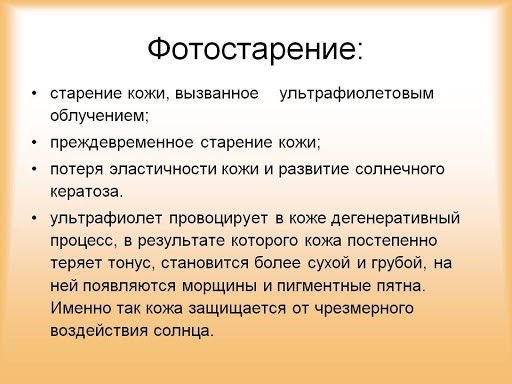The main factor in exogenous skin aging is ultraviolet irradiation (UVR). Depending on the nature of the biological effect on the body, ultraviolet waves are divided into three spectra: UV-A - from 320 to 400 nm; UV-B ─ 290 to 320 nm; UV-C ─ 200 to 290 nm. UV-C radiation, which is the most aggressive for the skin and is retained by the ozone layer of the atmosphere. UV-B is completely absorbed by the epidermis, its damaging effect lies, in particular, in the photochemical dimerization of thymine in DNA and the photoionization of amino acids with a free radical mechanism.
Find out in the article on estet-portal.com what are the causes and mechanisms of skin aging when exposed to a certain spectrum of ultraviolet rays.
- UV spectrum, which plays a leading role in skin aging
- Photoaging as biological skin aging
- Mechanism of skin aging under ultraviolet irradiation
Ultraviolet spectrum, which plays a leading role in skin aging
UV-A is much less aggressive, but its rays actively penetrate the dermis. The damaging effect of type A ultraviolet is indirectly through the formation of reactive oxygen species (ROS).
Follow us on Instagram!
Endogenous chromophores, such as riboflavin, porphyrins, NADP, activate the formation of reactive oxygen species, that is, act as photosensitizers.
How skin condition affects the choice of facial rejuvenation tactics
In one of the early studies on a compromise between the need for artificial UV exposure of the population in the conditions of the North and its negative effects on the skin, it was found that during chronic exposure to UV light in guinea pigs the content of vitamin C in the skin of animals decreases significantly, which can be explained by the depletion of its reserves by participation in the neutralization of UV-induced free radicals and reactive
Biochemical and histochemical methods have established that skin photodamage is characterized by an increase in the amount of glycosaminoglycans, proteoglycans, abnormal elastin fibers with simultaneous loss of collagen.
It has been shown that after ultraviolet irradiation of the skin, the content of unnatural Db-aspartic acid residues, which is a marker of skin aging, significantly increases in the composition of elastin.
The authors of the study believe that several mechanisms unfold in parallel during photoaging and biological aging of the skin. Among them: ultraviolet irradiation activates receptors for epidermal growth factor (EGF), interleukin-1 (IL-1) and TNF-a on the surface of keratinocytes and fibroblasts.

Activated receptors stimulate cascade signal transduction mechanisms, which result in the induction of transcription of the key substance ─ activator protein-1 (AP-1), which, in turn, stimulates the synthesis of MMPs,
which begin to destroy the matrix. AP-1 also directly inhibits the expression of the gene responsible for the synthesis of procollagen.
How skin aging occurs: the morphology of age-related changes in the skin Another mechanism is triggered by the fact that ultraviolet irradiation activates NADP-dependent oxidase in keratinocytes and dermis. This enzyme reduces molecular oxygen to superoxide ·O2-, which is then converted into the sequences: H2O2, · OH, 1O2.
These reactive oxygen species are destructive to cell membrane lipids and. Mechanism of skin aging under ultraviolet irradiation
Another parallel mechanism is the activation of protein kinase-mediated metabolic pathways by UV light, which finally leads to the synthesis of AP-1, inducing the synthesis of MMP-1, MMP-3 and MMP-9. MMP-1 cleaves collagen types I and III only in one place ─ the helical fiber,
but this is enough for MMP-3 (stromelysin-1) and MMP-9 (gelatinase B) to complete the process of protein degradation.
Acids in the gun: how acid choice affects the effect of chemical peels
As for pigment metabolism, it is a long established fact that the activation of the tyrosinase reaction under the action of ultraviolet irradiation, the end product of which are two forms of melanin ─ eumelanin and pheomelanin.
More useful information on our YouTube channel







Add a comment